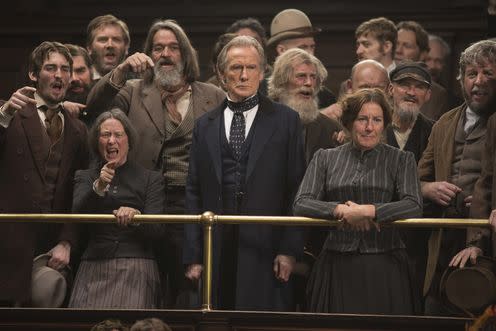Sex, secrets and murder most foul: following the threads of the Limehouse Golem
Lionsgate
Peter Ackroyd’s novel Dan Leno and the Limehouse Golem (1994) features in two adaptations this September: Opera Philadelphia’s Elizabeth Cree, and Juan Carlos Medina’s film The Limehouse Golem. It seems that this is the golem’s moment – but why does Ackroyd’s neo-Victorian novel speak to us now, and how far does Medina capture the London of 1880?
The titular golem is a serial killer whose true identity may be the (fictional) journalist John Cree, or the (real life) music hall performer Dan Leno, Karl Marx, or the novelist George Gissing. The worlds of music hall and of the reading room at the British Museum collide violently, reflecting Ackroyd’s fascination with histories written over each other. The film makes this image literal; the golem’s confessions scrawled over a copy of de Quincey’s On Murder Considered As One Of The Fine Arts provide the vital clue.
The Ghost of a Flea.William Blake/Tate Britain
Literary interplay is present in the figure of the golem itself. A mythical creature from Jewish folklore, the film takes the image of the golem not from Hebraic literature but from William Blake’s painting The Ghost of a Flea (1819-20). Ackroyd fans will enjoy this reference to Blake’s influence on Ackroyd and on other psycho-geographic novels of murders in Limehouse and Whitechapel (most notably Alan Moore’s graphic novel From Hell).
Shades of the Ripper
While the setting of The Limehouse Golem predates the 1888 Whitechapel murders, both film and novel borrow liberally from the imagery of Jack the Ripper. This return to Ripper mythology is timely in the context of debates on how such events should be memorialised. The Jack the Ripper museum, opened in 2015, drew criticism for its glamorisation of Jack, and for its replacement of an original plan for a museum of East End women (as opposed to their murderers). While The Limehouse Golem employs many of the familiar Ripper tropes, there is an element of parody about them and the film has been described as putting a more feminist slant on its graphic imagery of East End prostitutes being disembowelled.
The Ripper crimes were sensationally reported in the Illustrated Police News, a publication prominently featured in the film. Yet the film draws considerably on a sensational scoop in a rival publication, the Pall Mall Gazette. The journalist and editor WT Stead’s series: The Maiden Tribute of Modern Babylon (1885) explored not murder, but child prostitution.
Dangerous streets of Victorian London.Lionsgate
Victorian sex trade
Stead exposed the sexual trade in children by going undercover to show how easy it was to buy one. His report of July 6, 1885 carried the attention grabbing headline: “A child of thirteen bought for £5”. While Stead’s purchase of the child Eliza Armstrong had wider moral purposes, the exercise nevertheless earned him six months in Holloway Prison. Armstrong, by contrast, escaped to the Salvation Army in France.
The Maiden Tribute blended journalism with sensationalism and classical myth. Stead framed his report using Ovid’s myth of the Minotaur, the man-bull hybrid imprisoned in the labyrinth and fed by child sacrifices (the “maiden tribute”). In Stead’s update, London became the labyrinth, and sexual desire the beast. Stead cast himself as the hero Theseus, slaying the monster and finding his way out of the maze with a piece of thread, but legally found himself turned into the Minotaur.
While the Maiden Tribute appeared five years after the setting of The Limehouse Golem, film subtly references Stead’s work and its context. Elizabeth’s childhood sexual experiences are an obvious example – more subtly, Inspector Kildare (played by Bill Nighy), initially at a loss in his investigation, comments that “I just follow the threads”. Henry Goodman’s cameo as Karl Marx makes the point explicit when he says that the Golem’s victims are “sacrificial tributes in this labyrinth of London”.
Sex and the city
The outcomes of Stead’s investigations are also felt in The Limehouse Golem. The ensuing outcry led to the Criminal Law Amendment Act of 1885, raising the age of consent from 13 to 16, while the act’s Labouchere Amendment criminalised homosexuality. When, in Medina’s film, Kildare keeps his homosexuality secret, and Vincent comments that a girl is sexually available once she is 16, it becomes clear that this version of 1880 is ahead of its time.
One might see these references as simple historical errors – and indeed The Limehouse Golem makes a few of them. Victorian hangmen did not work alone, nor in hoods, nor on the morning after sentencing. When the executioner comments that public hangings are reserved for the most hated criminals, he forgets that public hangings were abolished in 1868. No woman was cut in half in a magic trick until 1921 (though some were beheaded).
Yet in a sense this is to miss the point: this is an adaptation not of a Victorian text, but a neo-Victorian one. The Limehouse Golem is more about an idea of the Victorian city than its historical reality.
This article was originally published on The Conversation. Read the original article.
Christopher Pittard has received funding from the Arts and Humanities Research Council.

 Yahoo News
Yahoo News 


